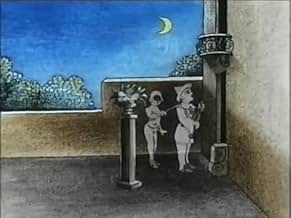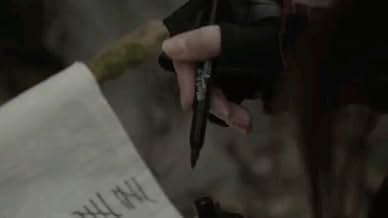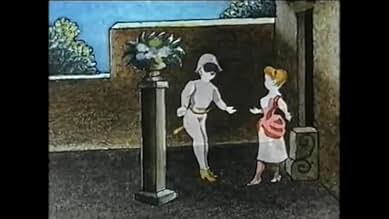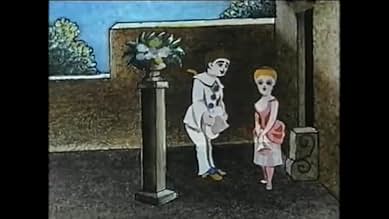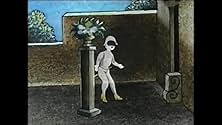NOTE IMDb
6,5/10
2,2 k
MA NOTE
Une nuit, Arlequin vient voir son amant Colombine. Puis Pierrot frappe à la porte et Colombine et Arlequin se cache. Pierrot commence à chanter mais Arlequin l'effraie et le pauvre homme s'e... Tout lireUne nuit, Arlequin vient voir son amant Colombine. Puis Pierrot frappe à la porte et Colombine et Arlequin se cache. Pierrot commence à chanter mais Arlequin l'effraie et le pauvre homme s'en va.Une nuit, Arlequin vient voir son amant Colombine. Puis Pierrot frappe à la porte et Colombine et Arlequin se cache. Pierrot commence à chanter mais Arlequin l'effraie et le pauvre homme s'en va.
- Réalisation
- Scénario
Avis à la une
Pauvre Pierrot, directed by Charles-Émile Reynaud, is one of the first animated films ever made. It is made up of 500 individually painted images and originally lasted about 15 minutes. The version available to today is a 4 minute version, restored from pieces of the original.
It's a simple story of a woman with two men wooing her, one she cares for, and the other which is somewhat a nuisance to her, even if he is sincere. To achieve his effects, Reynaud invented his Théâtre-Optique system which was basically a zoetrope with a projector. The images showed successive images of moving figures in front of blackbackgrounds. These images could be adjusted in real-time to project tthe animated characters against an immobile background image which was being projected by a second projector from a painted glass plate.
At times the show was quite elaborate. Original music and songs were written for the show, played by an piano accompanyist and sung by an actor. Reynaud performed 12,800 shows from 1892 to 1900. Commercially successful for a time, the popularity of these shows were eventually overtaken by the projected camera live action films of the Lumières and others.
It's a simple story of a woman with two men wooing her, one she cares for, and the other which is somewhat a nuisance to her, even if he is sincere. To achieve his effects, Reynaud invented his Théâtre-Optique system which was basically a zoetrope with a projector. The images showed successive images of moving figures in front of blackbackgrounds. These images could be adjusted in real-time to project tthe animated characters against an immobile background image which was being projected by a second projector from a painted glass plate.
At times the show was quite elaborate. Original music and songs were written for the show, played by an piano accompanyist and sung by an actor. Reynaud performed 12,800 shows from 1892 to 1900. Commercially successful for a time, the popularity of these shows were eventually overtaken by the projected camera live action films of the Lumières and others.
Cute and strange; oh, and it's the first animated thing put to film... ever. Impressive for that alone, AND it has a story! It may not be too deep, and may be a little confusing (what's with the guy that comes out of nowhere and steals the guy's ukulele or whatever it is, is he a ghost?) But it does have a beginning, middle and sort of an end, maybe, arguably. For what this french animator was able to accomplish - and did I mention in COLOR no less - and for the simple fact that this is one of the major accomplishments of that century, to get something with images moving, albeit jerkily, I say you should check out all four minutes on YouTube or wherever silent film shorts are sold.
This might be fairly basic animation compared to today's 3D computer-generated spectaculars, but it is in its own way just as remarkable. Emile Reynaud developed many marvels like this, and operated some rather tricky mechanism to screen it. Sadly, Reynaud was not only something of a perfectionist who personally hand-painted every image of every film, he also only trusted himself to operate the screenings. and therefore stretched himself a little too far. He was hugely successful before the advent of movies, but was incapable of progressing and stands as a singular warning of the fate that befalls any business that fails to adapt to a changing market. The film has historical importance, and as a bitter and impoverished Reynaud destroyed most of his films years after the film industry had made his shows obsolete, it's something of a minor miracle that it still exists today.
It's cheating a little to list this as a film as strictly speaking it's not one, though its maker Émile Reynaud pushed pre-cinema technology as far as it could go to achieve an experience practically indistinguishable from that of watching a theatrical presentation of an animated cartoon film. His Théâtre Optique featured his Praxinoscope, a radical development of old-established animation toys like the Zoetrope. This used rotating faceted mirrors and lenses that could project a succession of hand-drawn images from a paper strip with sprocket holes, allowing much longer sequences of continuous action than the short loops hitherto used in such devices. These images were then superimposed on a static background projected from a conventional magic lantern slide, prefiguring later cel animation techniques in which the image is broken down into a succession of layers with the minimum of movement in each one. The exhibition was completed with live narration and music.
Some of Reynaud's original elements survive (others he later threw in the Seine) and their affinity with film is demonstrated by the ease with which they can be reconstructed on modern film or video. Pauvre Pierrot was the first such production and is among the most charming, a simple tale featuring the traditional characters Pierrot, Arlequin and Colombine acting out their ancient love triangle. Some reconstructions replicate the translucent, slightly ghostly quality the characters would have had at the time. Sadly Reynaud's work was overtaken by the arrival of the cinema proper and he died a poor and unhappy man.
Some of Reynaud's original elements survive (others he later threw in the Seine) and their affinity with film is demonstrated by the ease with which they can be reconstructed on modern film or video. Pauvre Pierrot was the first such production and is among the most charming, a simple tale featuring the traditional characters Pierrot, Arlequin and Colombine acting out their ancient love triangle. Some reconstructions replicate the translucent, slightly ghostly quality the characters would have had at the time. Sadly Reynaud's work was overtaken by the arrival of the cinema proper and he died a poor and unhappy man.
It is said that Pauvre Pierrot (1892) was the first animated film ever (it was presented with Le Clown et ses chiens (1892) and Un bon bock (1892)). Was exhibited in October 1892 when Charles-Émile Reynaud opened his Théâtre Optique at the Musée Grévin. It is probably the first usage of film perforations. Pauvre Pierrot originally consisted of 500 individually painted images, which originally was 15 minutes long, but the 1996 restoration made it 4 minutes long.
The story is about Harlequin (best-known of the zanni or comic servant characters from the Italian Commedia dell'arte), Colombina (a stock character in the Commedia dell'Arte, she is Harlequin's mistress, a comic servant playing the tricky slave type and wife of Pierrot) and Pierrot (is a stock character of pantomime and Commedia dell'Arte). It is a comedy, though nowadays it isn't that funny, in its time it must have been one of the funniest things that existed. I wish I was there when it happened.
The story is about Harlequin (best-known of the zanni or comic servant characters from the Italian Commedia dell'arte), Colombina (a stock character in the Commedia dell'Arte, she is Harlequin's mistress, a comic servant playing the tricky slave type and wife of Pierrot) and Pierrot (is a stock character of pantomime and Commedia dell'Arte). It is a comedy, though nowadays it isn't that funny, in its time it must have been one of the funniest things that existed. I wish I was there when it happened.
Le saviez-vous
- AnecdotesThe cartoon was hand drawn on hundreds of sheets of glass, each inlaid in a leather strips, through which a light was shone projecting the figures on a backdrop, as it was spooled from one reel to another, much like a modern film reel.
- ConnexionsFeatured in La magie Méliès (2002)
Meilleurs choix
Connectez-vous pour évaluer et suivre la liste de favoris afin de recevoir des recommandations personnalisées
Détails
- Date de sortie
- Pays d’origine
- Langue
- Aussi connu sous le nom de
- Poor Pierrot
- Voir plus de crédits d'entreprise sur IMDbPro
- Durée5 minutes
- Mixage
Contribuer à cette page
Suggérer une modification ou ajouter du contenu manquant

Lacune principale
By what name was Pauvre Pierrot (1892) officially released in Canada in English?
Répondre
